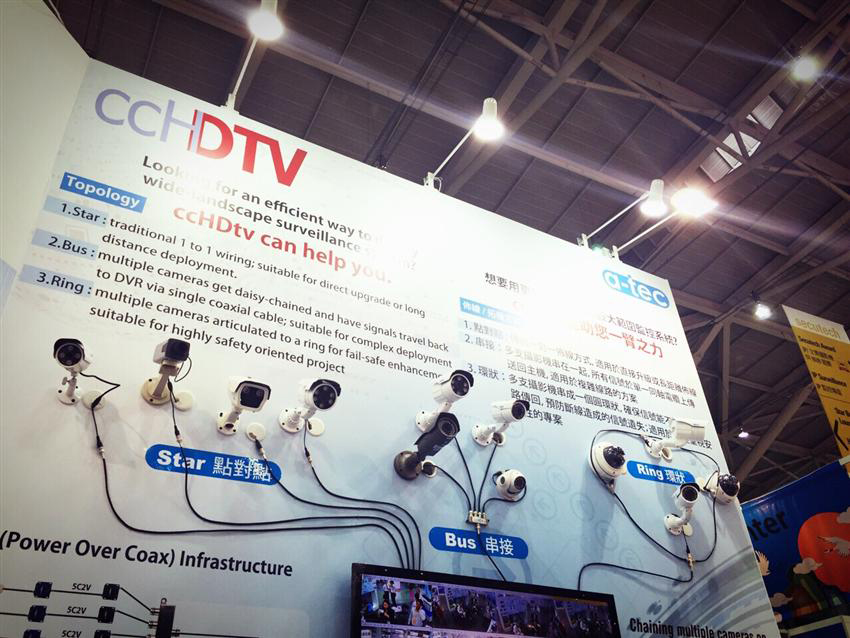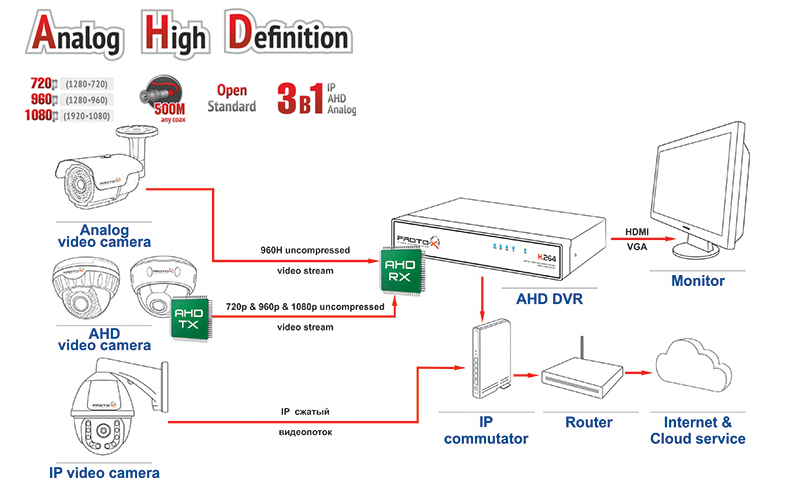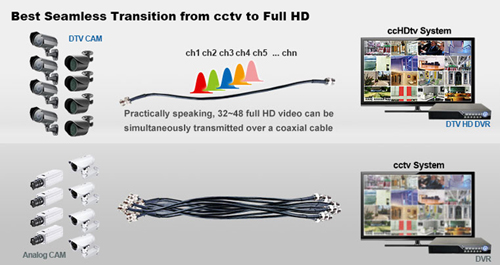
Analog HD technologies - AHD, HDTVI, HDCVI, ccHDtv, HDMDI
HD-over-coaxial solution prevails in analog video surveillance applications. Alf Chang - the a&s Consultant published his studies about the different analog high definition technologies including 960H, HD-CVI, ccHDtv, HD-MDI, HD-SDI and HD-TVI. Multiple HD-over-coaxial technologies coexist, inevitably brings some confusions to end-users, security installer, security integrators.
In this article we aim to offer HD-over-coaxial information which based on Alf Chang's studies. Apparently, IP-based video surveillance is becoming the dominant way of offering high definition video and convenience for remote monitoring. "The overarching view in the security industry right now is that IP, which employs a network infrastructure and offers HD video, will one day replace analog solutions, which have defined video surveillance for half a century. For analog players, who are seeing declines in sales and revenue, they must find ways to regain their former dominance in the industry. " quoted lines from Alf Chang.
Although the IP surveillance trend is inevitable and unstoppable, the shipment of analog video surveillance equipment still account for over 60 percent of the global market. We are still seeing the strong growth for analog video surveillance products from emerging markets especially in India, Vietnam, Nigeria, Kenya. The latest HD-over-coaxial solutions include AHD, ccHDtv, HD-CVI, HD-MDI, HD-SDI, HD-TVI, all these new technologies support high definition video transmitting over traditional coaxial cable. Alf Chang wrote that to be called HD-over-coaxial, the technology should meet the following six basic requirements:
- High quality images which have good clarity, true color reproduction, as well as high signal filtering, noise reduction
- Must transmit signal through coaxial cable, as HD-over-coaxial is claimed as a breakthrough technology, it must transmit signals for a longer distance
- The video recording/storage equipment must be back compatible with the 960H format, as well as the future compatibility with analog splitters and matrix systems must be considered.
- Video transmission should not be subject to no compression quality loss, no video latency.
- Easy to use and operate, supports hassle-free configurations on both front-end and back-end devices.
- Low-cost, but high quality solution
HD-TVI and AHD become popular HD-over-coax solutions
Among the latest analog high definition technologies, the HD-TVI and AHD are quite new. HD-TVI was developed by USA company - Techpoint. This new analog HD technology has been deployed into Hikvision's analog security products. Hikvision takes advantage of HD-TVI technology in order to against Dahua HD-CVI. At IFSEC 2015 London (Global security exhibition), Techpoint introduced its HD-TVI 2.0 version, now the HD-TVI supports 720p 30/25fps, 720p 60/50fps, 1080p 30/25fps high definition video transmission. Furthermore, HD-TVI receiver is back compatible with 960H format, which means the HD-TVI DVR can receive analog signals from analog 960H video cameras.
AHD stands for analog high definition, AHD is based on AHD standard which developed by Korean chip-set manufacturer - NextChip. AHD is able to deliver uncompressed 720p / 1080p high definition video over Cat 75-3 coaxial cable, and transmission distance up to 500 meters. This technology breakthrough the current HD video transmission limitation (<= 100 meters), it can achieve low-cost, long range, no video latency, high efficient megapixel resolution video transmission.
Both HD-TVI and AHD are open standard, which allows hundreds of manufacturers develop analog security cameras based on these technologies. Additionally, compared with other technologies, the cost for HD-TVI and AHD is extreme low, end-users can enjoy the analog high definition video surveillance with same price as traditional analog camera.

Mature analog high definition solution - Dahua HDCVI
Dahua developed and promoted the high-definition composite video interface (HD-CVI) which based on megapixel CMOS image sensors with its own in-house image signal processor (ISP). Based on the transmission technology of HD images over coaxial cables, the HD-CVI technology is a technology that captures high-definition progressive scan images, and transmits over coaxial cable in long distance.
On November 15th, 2012, Dahua released HD-CVI version 1.00 which specified the format: 720p (1280x720) and 1080p (1920x1080), which is similar to 700 TVL and 750 TVL.
HD-TVI, AHD, HD-CVI share one thing in common: different from 960H that utilizes CCD image sensor, HD-CVI and HD-TVI, as well as AHD adopt the megapixel resolution progressive scan CMOS image sensor or Sony Exmor CMOS sensor. The megapixel CMOS image sensor is able to capture images with high definition resolution. The widely used CMOS image sensors are from Aptina, Sony, Omnivision, Pixelplus. Additionally, all of them use point-to-point transmission of coaxial cables to produce uncompressed megapixel analog video images, without delay and without compromising image quality. HD-CVI and HD-TVI, as well as AHD can transmit HD analog video up to 500 meters over traditional video coaxial cable, breaking the distance limit of HD analog video transmission.
ccHDtv (High definition closed-circuit television)
ccHDtv (High definition closed-circuit television) is a new high definition video surveillance solution. The core concept of ccHDtv is utilizing multiple video technologies to transmit high definition signal over coaxial cable, or even transmit wirelessly; in real test, ccHDtv solution can support 1080p 30fps or 1080p 60fps video over a 5C2V/RG6 coaxial cable.
ccHDtv is developed by iTE Tech, a Taiwanese semiconductor manufacturer. This solution utilizes DTV technologies including DVB-T, ISDB-T, and ATSC standards and solves bandwidth and storage problems faced by traditional analog CCTVs in the past. From market share survey, ccHDtv is not a popular solution, because only few companies adopt this solution into their analog HD products.

HD-MDI (High definition medium dependent interface)
HD-MDI stands for high definition medium dependent interface, which is a completely different analog HD solution. Based on twisted pair, HD-MDI transmits high definition audio and video using a structure that is similar to traditional analog video surveillance system. The HD-MDI products include HD-MDI cameras, HD-MDI repeater, HD-MDI DVR, HD-MDI Optical Device, HD-MDI matrix, and HD-MDI audio video capture cards.
Opposite to coaxial cable, HD-MDI uses an unshielded twisted pair (UTP) to transmit uncompressed and no latency high definition video. Currently, the HD-MDI supports 720p / 1080p 30fps high definition video formats. This transmission method also allows HD-MDI to transmit video over Cat 5 or Cat 6 network cables without additional cost on cabling and switches.
What are advantages of HD-MDI?
- High definition video without compression, high clarity, no video latency
- Pure physical layer, no operating system, low power consumption, stability much better than IP camera
- Point-to-point video transmission, high stability and reliability
- HD video signal can transmit to HD-MDI encoder for video displaying, switching, analistic
- Using the unshielded twisted pair (Cat 5 or Cat 6 Ethernet cables) to transmit signal, no additional wiring cost
HD predecessor - Sony 960H
Since 960H emerged in 2011, Sony introduced the concept of Effio which includes some new CCD image sensors and Effio ISP that enhance the quality of CCTV. Before the HDCVI and HDTVI, as well as AHD, Sony 960H solution dominated the analog surveillance market. Consequently, Nextchip and Samsung developed its own CCD image sensors and image signal processors to join the competition. In the past, the majority of analog video cameras adopt CCD image sensors from manufacturers such as Sony, Panasonic, Samsung, Sharp.
The combination of Effio ISPs and CCD image sensors can produce over 650TVL of horizontal resolution, even up to 750 TVL which is closed to high-definition resolution. Compared the past traditional analog video, the Effio offered 2D and 3D digital noise reduction, wide dynamic range, automatic scene detection, digital image stabilization etc video enhancing technologies.
Without having to alter existing deployments of cables, the solution is regarded as the most viable way of reaching high-resolution images for analog cameras. The solution has postponed the demise of analog surveillance systems and has prevented it from being phased out of market too soon.

Comparison between different HD-over-coaxial technologies
What's the difference between IP camera and HDTVi? Which solution is better between HDTVI and AHD? Every day, our technical department receives these questions. Since each of solution has prons and cons, it's difficult to give you a simple answer. To choose your ideal solution for video surveillance, you may spend the time to analysis your needs from different perspectives. In order to know each solution advantages and disadvantages, you can check the following comparison table.
| Technology | 960Н | HDCVI | HDTVI | AHD | HD-SDI | IP |
| Standard | open | private | open | open | open | open |
| Chipset | CCD+DSP | CMOS+ISP | CMOS+ISP | CMOS+ISP | CMOS+ISP | CCD/CMOS+DSP |
| Signal type | analog | analog | analog | analog | digital | digital |
| Image Quality | rite | very good | very good | very good | excellent | very good |
| Resolution | 700TVL | 720P/1080P | 720P/1080P | 720P/1080P | 1080P | 720P/1080Р and more |
| Coax infrastructure compatibility | high | high | high | high | medium | converter is required |
| Hybrid real-time mode (CCTV+HDCCTV+IP) | no | yes | yes | yes | no | no |
| Solution difficulty | medium | medium | medium | low | medium | high |
| Max line distance without repeater, m (cable 5С-2V) | 200 cable 5С-2V, РК75-5 | 500 cable 5С-2V, РК75-5 | 500 cable 5С-2V, РК75-5 | 500 cable 5С-2V, РК75-5 | 150 cable 5С-2V, РК75-5 | 150 cable Cat.5 |
| Cable type | coax | coax | coax | any coax | coax | twisted pair |
| Cable quality requirements | medium | medium | medium | low | high | low |
| Signal | CVBS | CVBS | CVBS | CVBS | SDI | IP |
| Compression/losses | no | no | no | no | no | yes |
| Latencies | no | no | no | no | no | yes |
| Video recorder | 960H DVR | HDCVI DVR | HDTVI DVR | AHD DVR | SDI DVR | NVR |
| Maintenance difficulty | low | low | low | low | low | high |
| Solution cost | low | medium | low | low | high | high |
FAQ for HD-Over-Coaxial solutions
Do HDTVI and AHD can connect with any type of DVR?
Answer: The answer is no. Each of analog high definition solution has its own format and specification, it must work with its own DVRs. The only solution that's compatible with all formats is 960H. After testing, it was confirmed that different-brand HDTVI and AHD cameras can work with their respective DVRs, as long as the same format is used.
Will HDCVI and HDTVI completely replace 960H?
Answer: The answer is no. In terms of what the 720p HD-over-coaxial solution can offer, it is indeed very similar to 960H image quality. However, 960H products still stand out since they are offered and supported by most of the current camera vendors.
Can the HDTVI DVR and HDCVI DVR support 720p and 1080p simultaneously?
Answer: The answer is no. Test results show that HDTVI, HDCVI and AHD each can support 720p ad 1080p cameras and corresponding 720p and 1080p DVRs. The issue right now is whether the same DVR can record 720P and 1080P videos at the same time, no matter which technology is employed. This still needs to be confirmed.
Get My Latest Posts
Subscribe to get the latest updates.
Your email address will never be shared with any 3rd party.
Scan me




